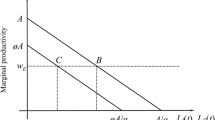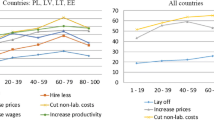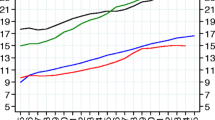Abstract
The persistence of high rates of unemployment in Europe has focused renewed attention on the wage determination process. One aspect which has received particular attention recently is the extent to which wages are determined by insiders, with outsiders having little impact on the wage bargain. If outsiders are disenfranchised in the wage determination process, they may be unable to underbid themselves into employment. The insider-outsider model, and the associated implication of hysteresis, thus provides a possible explanation for persistent involuntary un-employment.
Most empirical work on the importance of the insider-outsider model and hysteresis has been done at the aggregate level, either by testing whether wage growth is related to the level or the change in unemployment, or by testing if employment or unemployment follows a random walk. This paper extends both of these lines of analysis to the industry level. Based on a specification which nests alternative models of the wage determination process, estimation results are presented for fifteen industries using annual data for fourteen industrialized countries, and for pooled time-series cross-country data. The paper also tests the hypothesis that only industry-specific variables are important to the determination of industry wages and considers whether differences in industry wage determination might help to understand cross-country differences in unemployment.
The results offer considerable support to the insider view of wage determination. Industries in which wages seem to be determined by a natural rate/Phillips curve model — the primary competing model considered in the paper — appear to be the exception rather than the rule. Moreover, at the industry level hysteresis does not appear to characterise wage formation in the high-unemployment European countries to a greater extent than in North America and Japan.
Similar content being viewed by others
References
Blanchard O (1988) “Unemployment: Getting the Questions Right — and Some of the Answers”, NBER Working Paper No. 2698 (September)
Blanchard O, Summers L H (1988) “Hysteresis and the European Unemployment Problem”, in Cross (1988), pp. 306–64 and in S. Fischer, ed., NBER Macroeconomics Annual, 1986, MIT Press, pp. 65–71
Blanchflower D G, Oswald A J, Garrett M D (1987) “Insider Power in Wage Determination: Part II”, mimeo (June)
Burda M, Sachs J (1987) “Institutional Aspects of High Unemployment in the Federal Republic of Germany”, NBER Working Paper No. 2241 (May)
Coe D T (1988) “Hysteresis Effects in Aggregate Wage Equations”, in Cross, ed. (1988), pp. 284–305
Chan-Lee J H, Coe D T, Prywes M (1987) “Microeconomic Changes and Macroeconomic Wage Disinflation in the 1980s”, (OECD Economic Studies (Spring), pp. 121–57
Cross R ed (1988) Unemployment, Hysteresis & the Natural Rate Hypothesis, Oxford: Basil Blackwell
Friedman M (1968) “The Role of Monetary Policy”, American Economic Review (March), pp. 1–17
Gordon R J (1988) “Back to the Future: European Unemployment Today Viewed from America in 1939”, Brookings Papers on Economic Activity (No. 1), pp. 271–312
Hendry D F (1986) “Econometric Modelling with Cointegrated Variables: An Overview”, Oxford Bulletin of Economics and Statistics (No. 3), pp. 201–12
Katz L (1986) “Efficiency Wage Theories: A Partial Evaluation”, NBER Working Paper No. 1906 (April)
Kuh E (1967) “A Productivity Theory of Wage Levels — An Alternative to the Phillips Curve”, Review of Economic Studies, pp. 333–60
Lindbeck A, Snower D J (1986a) “Wage Setting, Unemployment, and Insider-Outsider Relations”, American Economic Review (May), pp. 235–9
Lindbeck A, Snower D J (1986b) “Efficiency Wages versus Insiders and Outsiders”, European Economic Review Proceedings, pp. 407–16
Lindbeck A, Snower D J (1988a) “Cooperation, Harassment, and Involuntary Unemployment: An Insider-Outsider Approach”, American Economic Review (March), pp. 167–88
Lindbeck A, Snower D J (1988b) “Long-Term Unemployment and Macroeconomic Policy”, American Economic Review (May), pp. 38–49
Meyer-zu-Schlochtern F J M (1988) “An International Sectoral Database for Thirteen OECD Countries”, OECD ESD Working Papers No. 57 (November)
Milbourne R D, Purvis D D, Scoones W D (1989), “Unemployment Insurance and Unemployment Dynamics”, Institute for Economic Research Discussion Paper No. 750, Queen's University (June)
Nickell S (1988) “The Supply Side and Macroeconomic Modeling”, in R. Bryant, et al., ed., Empirical Macroeconomics for Interdependent Economies, Brookings Institution
Nickell S, Kong P (1988) “An Investigation into the Power of Insiders in Wage Determination”, Oxford Applied Economics Discussion Paper No. 49 (June)
Nickell S, Wadhwani S (1988) “Insider Forces and Wage Determination”, Institute of Economics and Statistics, University of Oxford, mimeo (March)
Salop S (1979) “A Model of the Natural Rate of Unemployment”, American Economic Review (March), pp. 117–25
Sargan J D (1964) “Wages and Prices in the United Kingdom: A Study in Econometric Methodology”, in P.E. Hart, et al., ed., Econometric Analysis for National Economic Planning, London: Butterworths
Sargan J D, Bhargava (1983) “Testing residuals from Least Squares Regression for being Generated by the Gaussian Random Walk”, Econometrica (January), pp. 153–74
Snower D J (1988) “European Unemployment: The Insider-Outsider Explanation and its Policy Implications”, CEPR Bulletin (June), pp. 3–7
Solow R (1985) “Insiders and Outsiders in Wage Determination”, Scandinavian Journal of Economics (No. 2)
Author information
Authors and Affiliations
Additional information
This paper was started when the author was at the Economics and Statistics Department of the Organisation for Economic Cooperation and Development. Views expressed are the author's and do not necessarily reflect those of either Organisation. I am grateful to Palle Schelde-Andersen, John Martin, Steven Fries and Steve Englander for helpful comments and suggestions; and to Valerie Barca for excellent trans-Atlantic research assistance.
Rights and permissions
About this article
Cite this article
Coe, D.T. Insider-outsider influences on industry wages. Empirical Economics 15, 163–183 (1990). https://doi.org/10.1007/BF01973451
Issue Date:
DOI: https://doi.org/10.1007/BF01973451




